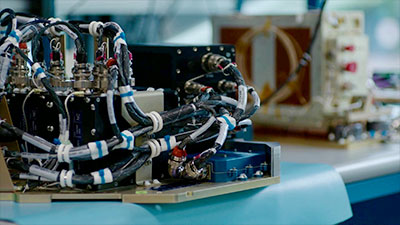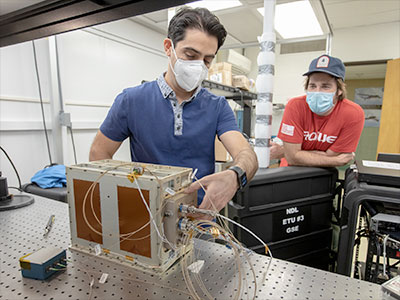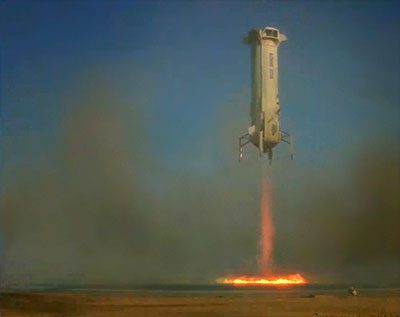 Space News space history and artifacts articles Messages space history discussion forums Sightings worldwide astronaut appearances Resources selected space history documents |
If you have previously registered, but forgotten your password, click here.
Technologies to enable exact and soft landings on the Moon and other worlds will fly on Blue Origin's next New Shepard suborbital rocket launch, currently targeted for 11:00 a.m. EDT Thursday, Sept. 24. The rocket's flight path is relevant to lunar landings, providing a unique opportunity to mature sensors and algorithms for potential use on Artemis missions. "This public-private partnership is a great example of NASA and industry working together on common goals – to explore more of the Moon and eventually land humans on Mars," said Jim Reuter, associate administrator for NASA's Space Technology Mission Directorate (STMD). STMD selected Blue Origin for a Tipping Point award in 2018 to help increase access to planetary surfaces. Sensors and specialized software are fundamental to NASA's Safe and Precise Landing – Integrated Capabilities Evolution (SPLICE) technology suite. This flight test, the first of two under the Tipping Point partnership, will demonstrate the performance of two NASA-developed precision landing sensor systems, advanced algorithms, and a new computer. The rocket launch won't be the first for some SPLICE components – NASA's Flight Opportunities program based at the agency's Armstrong Research Center in Edwards, California, enabled tests on other commercial platforms. But this is the first integrated test for the computer with two of the three SPLICE sensor systems. So, before the technologies make their way to the Moon or elsewhere in the solar system, NASA is taking advantage of another proven testing platform.  Above: NASA's SPLICE descent and landing computer (foreground) and navigation Doppler lidar engineering test unit (background) undergo preparations for a suborbital flight test. (Blue Origin) Leading up to the New Shepard launch (NS-13), Blue Origin installed the sensors onto the upper portion of the reusable rocket booster and integrated the custom SPLICE descent and landing computer and remaining hardware into the booster. During the approximately 12-minute venture from Earth to space and back to Earth, SPLICE will collect data on the range of operations for each component to help the team better understand how the elements work together and on the same timetable during a lunar-relevant descent and landing. "Testing SPLICE technologies on a suborbital rocket expands the envelope beyond previous lab tests, helicopter field tests, and lower-altitude suborbital rocket tests," explained John Carson, technical integration manager for precision landing based at NASA's Johnson Space Center in Houston. "We will get more data about the system to anchor analyses and models and support follow-on adjustments, testing, and development." Segments of the rocket's flight profile mimic a spacecraft landing on the Moon. New Shepard will lift off toward space and reach an altitude of approximately 62 miles (100 kilometers). The SPLICE hardware will briefly experience what it is like to operate in microgravity and the vacuum of space. Next, the capsule – carrying other cargo, including eight Flight Opportunities payloads and tens of thousands of postcards from Blue Origin's nonprofit Club for the Future created by Artemis Generation students – will separate from the booster and fly free in space. The rocket booster will descend vertically back to Earth. The two NASA sensor systems, a computer, and supporting software will get to work during the controlled descent. The first sensor system is for terrain relative navigation that incorporates software developed by Draper of Cambridge, Massachusetts. This system kicks off an emulated landing sequence on New Shepard. Terrain relative navigation uses two proven sensors mounted to the rocket – an inertial measurement unit and a camera. The software uses real-time information from the camera, its "eyes," to make comparisons with pre-loaded surface maps to determine the rocket's exact location. The technology, which is akin to the system NASA's Perseverance rover will use to land on Mars in February 2021, could land spacecraft precisely on another world.  Above: Langley engineers Aram Gragossian, left, and Jacob Follman, right, configure the electronics within a navigation Doppler lidar engineering test unit. (NASA/David C. Bowman) The second sensor system to fire up during the flight test is a navigation Doppler lidar, developed at NASA's Langley Research Center in Hampton, Virginia. The new sensor uses a laser to enable precise soft landings on the Moon and Mars. Navigation Doppler lidar sends laser beams to the surface and detects the reflected returns to determine the lander's velocity and altitude. The data from this test will let the team model how it will function during lunar landing and how it is affected by a planet's atmosphere – in this case, Earth's. "The sensor data is all processed via the descent and landing computer," explained Carson. "Lots of other software runs in the background, integrating the different systems, figuring out what needs to run next, and, for this test, synchronizing timing with the Blue Origin flight computer. It's all crucial so the system can run autonomously and provide us with data that we can analyze post-flight." While it won't fly on this flight, a third SPLICE sensor system called hazard detection lidar scans a surface to create a 3D map of the landing field. This data allows the SPLICE computer and software to identify challenging terrain and determine a safe landing location for a robotic or human mission to touch down. "Precision landing is critical for a sustainable lunar future that builds a lunar base with successive missions," said Brent Sherwood, vice president of Advanced Development Programs, Blue Origin. "On New Shepard together with NASA, we are demonstrating in flight the capabilities America can use to conduct lunar exploration." NASA designed the elements to work together or separately. One or all of the capabilities could be integrated into a spacecraft, depending on the destination and mission requirements. "We develop and test new technologies so that NASA and industry can use variations of them based on the mission need," said Game Changing Development Program Executive Niki Werkheiser. The program manages SPLICE's technology development. "Since a one-size-fits-all solution for landing on other worlds isn't feasible, we are bringing about flexible, next-generation capabilities that NASA and our partners can apply to a variety of missions." NASA's navigation Doppler lidar system will fly on two commercial robotic lunar landers targeted for flights in 2021. SPLICE technologies could also be considered for use to land the first woman and the next man on the Moon under NASA's Artemis program as well as for future Mars sample return missions. | ||||||||
| Robert Pearlman | Additional NS-13 payload details from Blue Origin (via Twitter): We've got 12 customers on board New Shepard for NS-13, including several from NASA. A thread highlighting some of these payloads: | |||||||
| Robert Pearlman | Blue Origin update The Tipping Point experiment today requires clear weather to gather usable data. We've delayed launch until 11:40 AM CDT / 16:40 UTC to allow for the cloud cover to clear in West Texas. | |||||||
| Robert Pearlman | Blue Origin update We've detected a potential issue with the power supply to the experiments. Launch is scrubbed for today. New launch target forthcoming. | |||||||
| Robert Pearlman | Blue Origin update New Shepard NS-13 mission with NASA Tipping Point experiment is now slated for launch at 10:00 AM CDT / 15:00 UTC tomorrow, Sept. 25. | |||||||
| Robert Pearlman | Blue Origin update New Shepard NS-13 launch is a no go for today [Sept. 25]. We are working to verify a fix on a technical issue and taking an extra look before we fly. New launch target forthcoming. | |||||||
| Robert Pearlman | Blue Origin update We're go for launch this morning (Oct. 13) at 8:35 AM CDT / 13:35 UTC. | |||||||
| Robert Pearlman | From Blue Origin (via Twitter): Congrats to the Blue Origin team for another successful launch.Unofficial flight statistics:
| |||||||
| Robert Pearlman | Blue Origin release New Shepard Successfully Completes Mission with NASA Precision Lunar Landing Technology Onboard | |||||||

